Quick answer: If you’re looking for the best AI website builder for Shopify, go with GemPages for flexible design, Shogun for performance-focused pages, or Zipify Pages if you’re chasing high conversions.
I’ve tested them all, and this guide breaks down what actually matters — so you can stop guessing and start building.
TL;DR: Best AI Website Builders for Shopify
Here’s a quick snapshot of the top AI website builders for Shopify — what they’re best at, why they matter, and how much they cost.
| Tool | Best For | Key Strength | Pricing (Starts At) |
|---|---|---|---|
| GemPages | Design flexibility | Drag-and-drop builder with AI | $23/month |
| Shogun | Speed and performance testing | Fast, split-tested pages | $39/month |
| Zipify Pages | High-converting landing pages | Conversion-focused templates | $67/month |
| PageFly | Budget-friendly custom pages | Free plan with flexible editor | Free / $24/month |
| Ecomposer | Low-cost builder with AI | Real-time editing + AI layout | Free / $19/month |
| Unbounce | Paid traffic landing pages | A/B testing + AI content | $99/month |
| Durable | Rapid MVP or campaign sites | Instant AI site generation | $15/month |
| 10Web | Hybrid content + Shopify embeds | AI-powered WordPress builder | $10/month |
What is Shopify?

Shopify is one of the biggest ecommerce platforms on the planet — and if you’ve ever bought anything from a small brand online, chances are it was powered by Shopify.
I’ve used it for multiple stores, and what keeps me coming back is how fast it is to launch. Within a few hours, you can go from idea to live site — selling products, taking payments, and managing orders.
Shopify handles the backend — inventory, payments, security, hosting — so you can focus on building your brand.
Where it gets really interesting is the app store: that’s where AI builders, CRO tools, and all the serious growth tools live.
Some quick stats to show how massive Shopify has become:
- 4.8 million stores are currently live on Shopify (2025)
- Shopify processed over $284 billion in GMV (Gross Merchandise Volume) in 2024
- Over 65% of Shopify traffic comes from mobile
- Shopify holds 10.3% of the global ecommerce platform market share, second only to WooCommerce
- Merchants using Shopify Plus see 126% YoY growth on average, according to internal data
- Shopify App Store has over 8,000 apps, including AI builders, upsells, SEO tools, and automations
Shopify isn’t just for beginners anymore. It powers everything from side hustles to enterprise brands doing 8 or 9 figures.
What makes it work is how easy it is to plug in tools to build exactly what you want — especially when AI starts doing the heavy lifting.
Pros and Cons of Using Shopify
After building and managing Shopify stores for a few years, here’s my take:
Pros:
- Beginner-friendly: You can drag and drop your way into a working store with no coding.
- App integrations: Massive library of tools and themes — AI builders, analytics, upsells, you name it.
- Secure and fast: Shopify handles hosting, speed, SSL, and server security for you.
- Scalable: Works whether you’re just starting or making millions.
Cons:
- Ongoing monthly fees: Between the base Shopify plan and app costs, things can add up.
- Customisation limits: Without third-party apps or coding, the native builder is basic.
- App overload: You’ll probably need several apps to get what you want — and that adds complexity.
Best AI Website Builders for Shopify
Here’s a breakdown of the top tools that actually work — based on real use, not hype.
1. GemPages
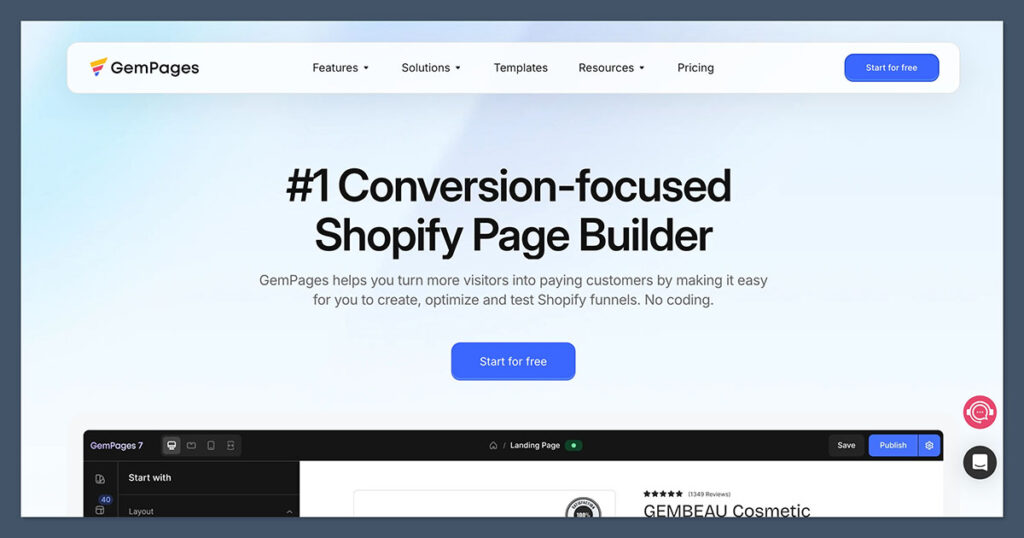
I came across GemPages when I was struggling to make my Shopify store look unique.
The default Shopify builder felt too limiting, and I didn’t want to code every section manually. GemPages gave me full freedom — drag, drop, tweak, test.
The AI suggestions even helped me lay out my product pages in a way that looked way more polished than what I started with.
Key features:
- Drag-and-drop visual editor
- AI layout suggestions
- Built-in image compression for speed
- Integrates with nearly all major Shopify apps
Pros:
- Flexible across product pages, landing pages, and blog layouts
- Fast-loading templates
- Great mobile responsiveness
- AI automatically adjusts design for screen size
Cons:
- Takes some time to learn all the tools
- Advanced templates locked behind higher plans
Pricing:
- Starts at $23/month
- Pro plan: $47/month
Best for: Store owners who want full design control without coding. If you’re someone who loves playing with layouts and wants to avoid hiring a developer, this is your tool. You’ll be able to build branded pages that don’t feel “Shopify generic.”
Pro Tip: Use the “Section Templates” feature to build reusable components — trust badges, reviews, timers — and roll them out across your store.
2. Shogun
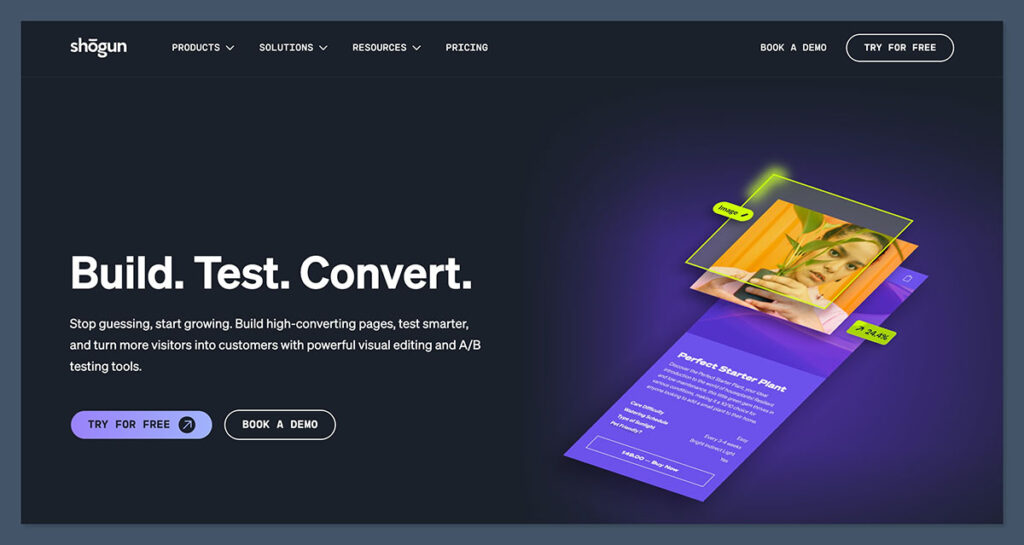
Shogun came into my life when I needed speed. I was scaling paid traffic to my Shopify store, and page load time was killing conversions.
Shogun delivered insanely fast pages, and I loved how I could test variants without needing a developer. It’s not the flashiest builder — but it’s all about performance.
Key features:
- Speed-optimised landing pages
- Split testing
- AI content suggestions
- Sections can be reused across pages
Pros:
- Very fast-loading
- Built-in CRO tools
- Works across Shopify and Headless
Cons:
- Expensive compared to others
- More advanced than beginners might need
Pricing:
- Starts at $39/month
- Advanced plans up to $149/month
Best for: Fast-growing brands focused on performance and testing. If you’re running ads or have a high-traffic store, this is the tool that pays for itself. You can test elements on the fly and shave seconds off your load time.
Pro Tip: Run A/B tests on “Add to Cart” buttons and headlines — small changes can make a huge difference in conversions.
3. Zipify Pages
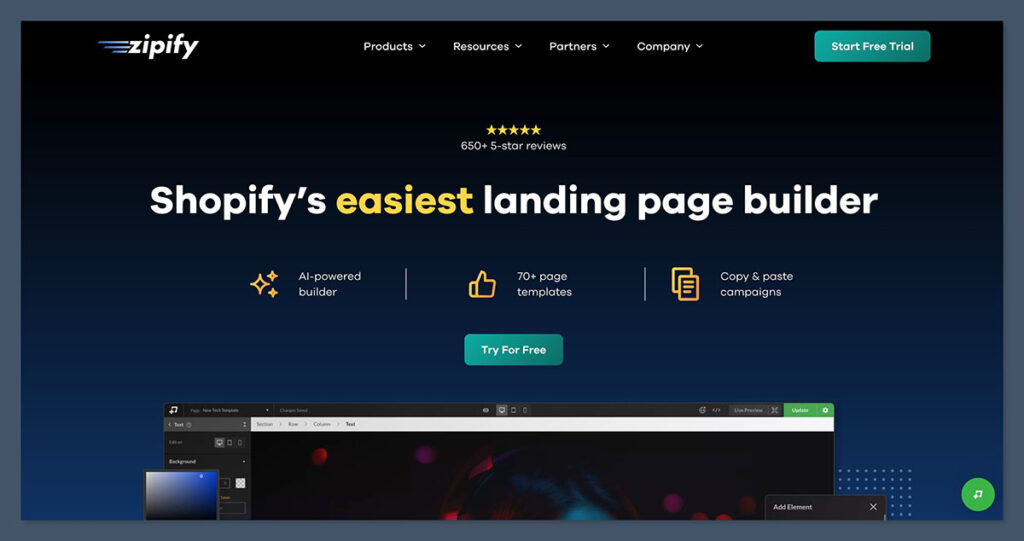
When I first tried Zipify, it felt like I finally had access to the playbook top ecommerce stores were using. Built by Ezra Firestone’s team, every template is designed to sell — hard. If you’re running offers, upsells, or email campaigns, this is a must-have.
Key features:
- Pre-built high-converting templates
- Countdown timers, urgency blocks
- Deep integration with Shopify checkout
Pros:
- Created for conversion
- Templates are clean and fast
- Integrates perfectly with Zipify OCU
Cons:
- Higher price
- Less design freedom
Pricing:
- Starts at $67/month
- Premium plan: $97/month
Best for: Ecommerce marketers and conversion-focused store owners. If you’re doing over $20K/month or pushing product launches, Zipify is built for you. It’s not about design — it’s about psychology, and every feature is based on that.
Pro Tip: Use the “Landing Page Funnel” feature to connect product pages, offer pages, and upsells into a seamless experience.
4. PageFly
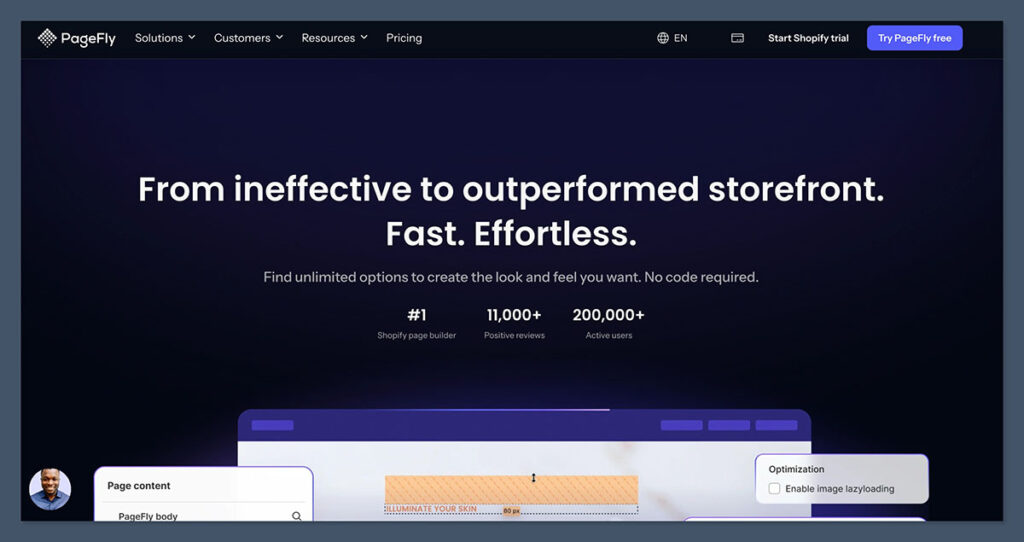
PageFly was the first page builder I ever used. I needed something free, and PageFly delivered. It’s clean, flexible, and more powerful than Shopify’s native editor — especially for product and landing pages.
Key features:
- Drag-and-drop builder
- Responsive previews
- Template library
- Works with Shopify 2.0 sections
Pros:
- Great free tier
- Works across most page types
- Responsive support
Cons:
- Limited AI features
- Free plan has branding
Pricing:
- Free plan available
- Paid starts at $24/month
Best for: New stores or Shopify beginners on a budget. You get a lot of value here without paying. It’s the best starting point if you’re building a small store or testing a product.
Pro Tip: Use PageFly sections to prototype new page layouts — then push them live once you’re confident they convert.
5. Ecomposer
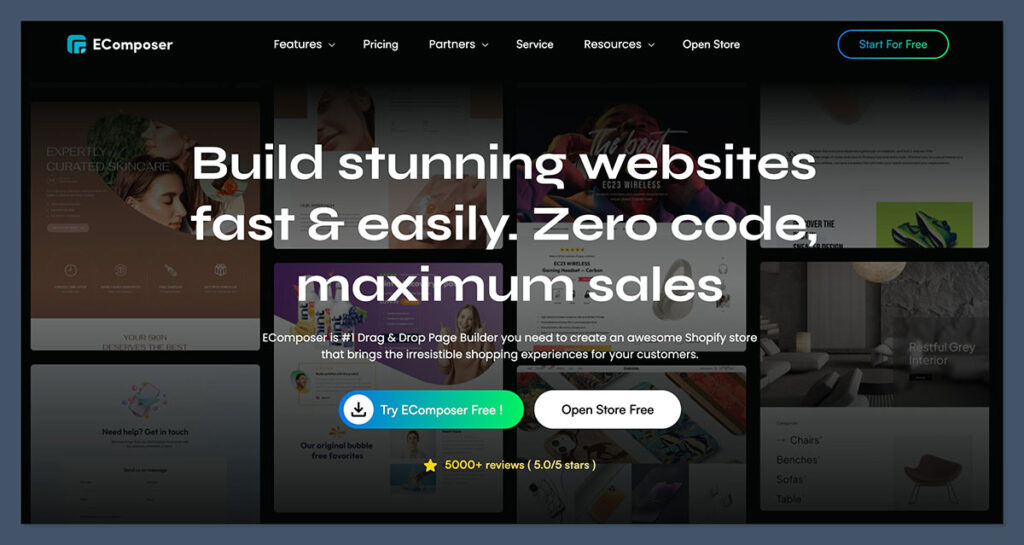
I found Ecomposer while looking for a lightweight builder with AI features. It’s surprisingly good for the price. Clean UI, decent AI layout tools, and smooth Shopify integration.
Key features:
- Real-time visual editing
- AI layout suggestions
- Fast-loading design
- Multilingual support
Pros:
- Lightweight
- Very beginner-friendly
- Good support
Cons:
- Still building out integrations
- Slightly less polish than top-tier tools
Pricing:
- Free plan
- Paid from $19/month
Best for: Store owners who want solid features without a big price tag. Ecomposer hits the middle ground. It’s not fancy, but it gets the job done — and you can build out full stores without feeling boxed in.
Pro Tip: Start with their “Conversion” template category — it’s packed with sections that boost trust and urgency.
6. Unbounce
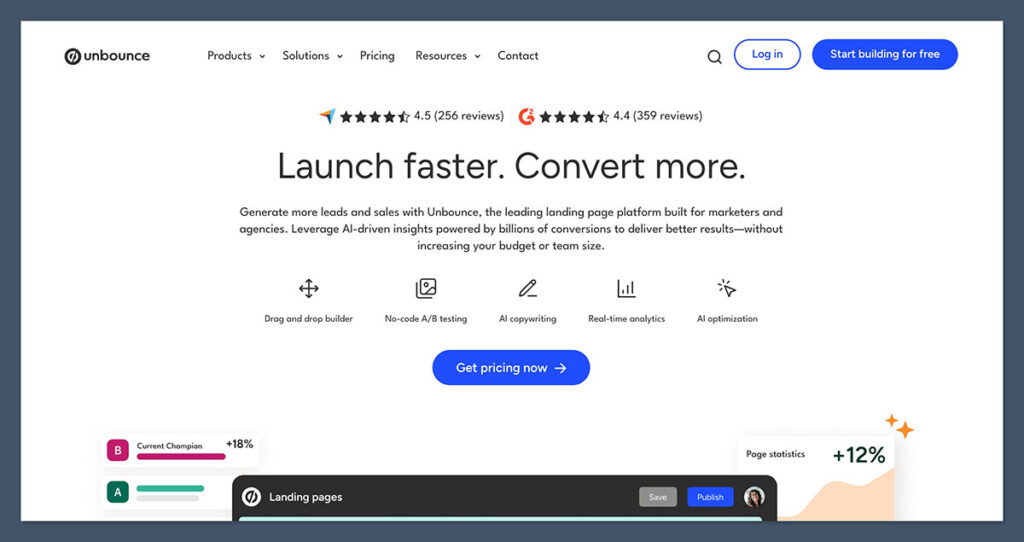
Unbounce isn’t Shopify-native — but if you’re running cold traffic to landing pages, nothing beats it. I used it to build dedicated funnels that drive traffic into Shopify checkouts. Clean, fast, and packed with AI copy tools.
Key features:
- AI text and layout suggestions
- A/B testing
- Smart traffic routing
- Drag-and-drop editor
Pros:
- Built for paid traffic
- Clean UI
- Smart features for marketers
Cons:
- High price point
- Requires manual Shopify integration
Pricing:
- Starts at $99/month
Best for: Brands doing heavy paid traffic or email campaigns outside of Shopify. Unbounce is how you test fast and drive qualified traffic to your product. I’ve used it for launches, bundles, and lead-gen offers.
Pro Tip: Use Unbounce’s Dynamic Text Replacement (DTR) with ad campaigns to match your page to each visitor’s search — helps with CTR and conversion.
7. Durable
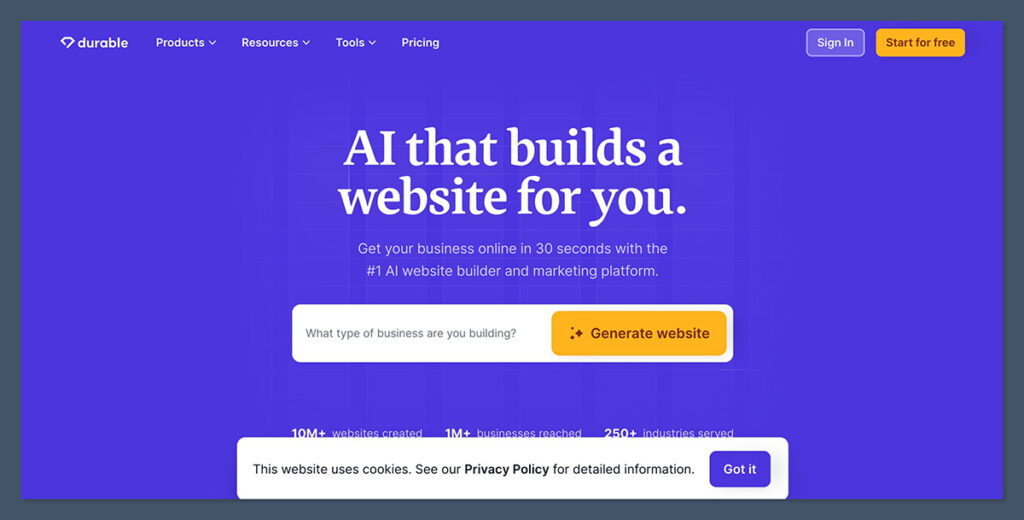
Durable is an AI site builder that literally builds your site in under a minute. It’s not Shopify-native, but it’s a great tool for MVP pages and fast launches.
Key features:
- AI instant site creation
- Built-in CRM
- Supports Shopify embeds
Pros:
- Incredibly fast
- Super beginner-friendly
- Includes forms, contact tools, blog
Cons:
- Not for full ecommerce
- Limited design flexibility
Pricing:
- $15/month
Best for: Launching pre-sale or campaign sites with Shopify product embeds. I’ve used it for Black Friday pages and new product launches when I didn’t want to touch my main store layout.
Pro Tip: Drop your Shopify “Buy Buttons” into Durable pages to create a fast, funnel-style buying experience without coding.
8. 10Web
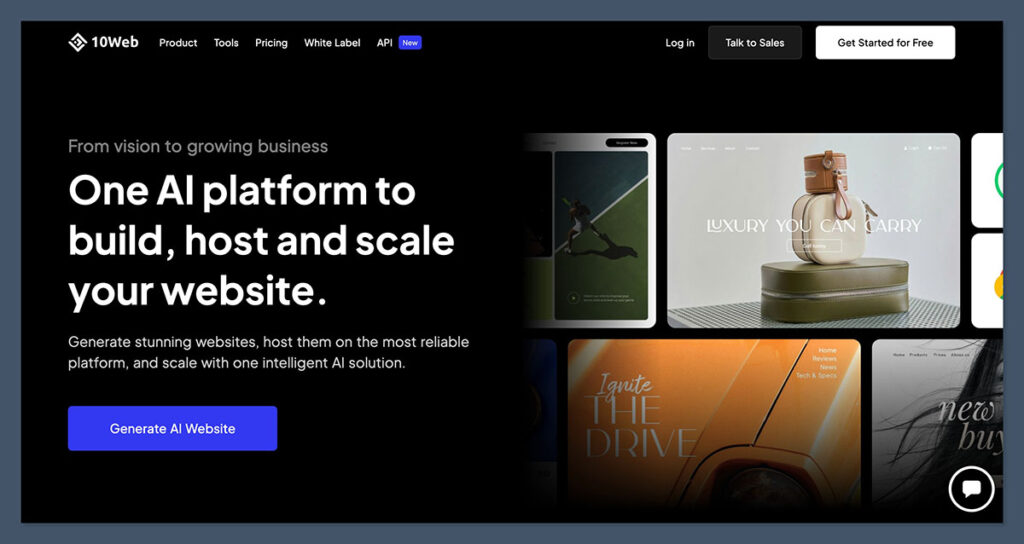
10Web is a WordPress builder with AI tools — but it can support Shopify by embedding products. It’s not plug-and-play, but it gives you way more content control if you’re SEO-focused.
Key features:
- AI layout builder
- Page speed optimisation
- Shopify embed-friendly
- Full backup/restore
Pros:
- High flexibility
- Optimised for SEO
- Cost-effective
Cons:
- Technical setup
- Best for hybrid stores
Pricing:
- From $10/month
Best for: Developers or agencies managing content-heavy stores with Shopify integrations. It’s great if you want long-form sales pages or SEO-focused content wrapped around Shopify products.
Pro Tip: Use 10Web to build high-quality blog or SEO landing pages — then embed Shopify products directly into that content.
How to Choose the Right AI Website Builder for Shopify
Picking the right AI website builder isn’t just about features — it’s about where your store is right now and where you want it to go. I’ve tried tools that looked good on paper but didn’t match how I actually work. So before you commit, ask yourself a few key questions.
Here’s what I look at:
1. Stage of your business
Are you just getting started or doing six figures already?
- If you’re early: You probably need something lean, flexible, and free/low-cost.
- If you’re scaling: Prioritise conversion tools, performance, and integrations.
2. Design freedom vs structure
Do you want total control or easy templates?
- GemPages and PageFly let you build from scratch.
- Zipify gives you proven layouts so you don’t have to think.
3. AI capabilities
Some builders (like Durable or Ecomposer) use AI to speed up layout and content.
Others, like Unbounce, use AI to route traffic or generate split test variants.
If AI is the reason you’re here, check how deep it actually runs in the tool.
4. Performance and speed
Google ranks fast sites higher.
Shogun and 10Web prioritise page speed with optimised code and compression.
Avoid bloated builders that kill load times.
5. Budget
You can get started with free tools like PageFly, but premium ones like Shogun or Zipify can be $50–$100+/month.
Make sure the ROI matches where your store’s at.
Conclusion
There’s no one-size-fits-all answer here — but there is a right choice based on your goals.
If you want total design control and flexibility, GemPages is my top pick. If you’re obsessed with performance and testing, Shogun is hands-down the most powerful.
If your goal is to sell more with proven layouts, Zipify will do the heavy lifting for you.
I’ve used all of these tools at different stages — launching side hustles, testing offers, scaling stores — and each one served its purpose.
My advice? Pick the one that fits your next 6 months, not just where you are today.
Try two or three, test them, and see which one fits how you work. Most offer a free trial or free plan — so there’s no excuse to sit on the fence.

Comments 0 Responses